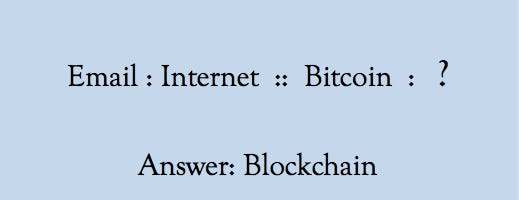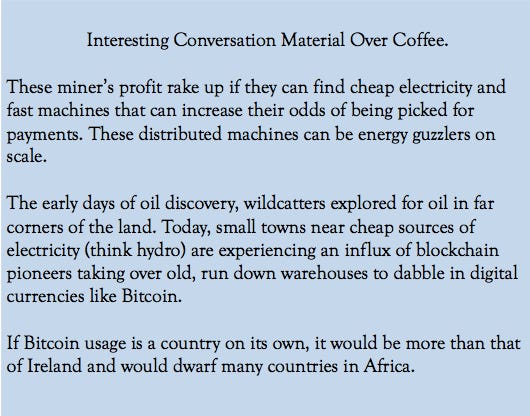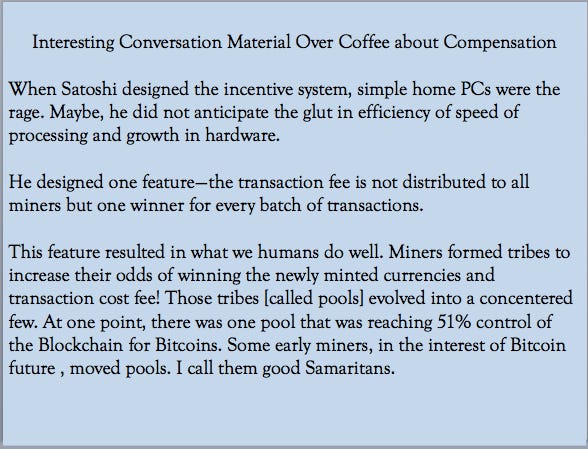Latest news about Bitcoin and all cryptocurrencies. Your daily crypto news habit.
No Jargons, Just the right mix for cocktail conversation
The goal of this article is to make you have awesome conversations around blockchain based on things you can relate — without getting technical.
Many times, the why is more interesting than the how. The intent of this post is to answer the why. First, what is Blockchain?
Mob or crowd — the word choice matters.
Internet is a concept– you do not see it, you can feel its presence.
When I saw an application using the Internet for the first time in the 1990s, the internet became more real. Yep, once upon a time, email delighted me on the possibilities of faster communication.
Just like the Internet, Blockchain is a concept. You do not see it, you can feel its presence through its applications.
What is the equivalent application like e-mail for blockchain? It is Bitcoin. A currency like US Dollar — except it is digital and not backed by any government.
Blockchain and Bitcoin start with a B. How to remember the concept from the application?
Application is something you see with your eyes and use frequently. Bitcoin has the word coin you can see and use frequently.
If you are thinking, “I can see a chain too.” A chain is more sobering like a concept. Concepts like Internet can be abstract and difficult to assimilate.
On the other hand, when I saw the power of email first time, my synapses were firing off.
This jargon free video replicated the same feeling for me for the new paradigm.
The gymnastics of digital ledger entry by the faceless bookkeepers in the video, making sure all entries are right and making sure nobody screws it up is Blockchain.
That is all cool. Is there a formal definition of Blockchain?
The global agreement on the definition for Blockchain is yet to crystallize. Let me share the simplest definition I am comfortable with (slightly modified from Ritesh’s definition):
A blockchain is a decentralized technology — distributed and incorruptible digital ledger that is used to record transactions across many computers.
What do you believe are the key takeaway words here?
1. My first word is technology.
Blockchain is a technology — a technology concept. That’s it. Core of it is a digital ledger with protocols around it.
2. My second word is transaction.
The Internet reduced the friction for information sharing — think about library visit vs. Google search.
Blockchain could reduce the friction for transaction processing.
How? [this is a business how, not technical how]
I call it the back office bonanza. I found a great example in this HBR article
“For example, a typical stock transaction can be executed within microseconds, often without human intervention. However, the settlement — the ownership transfer of the stock — can take as long as a week. That’s because the parties have no access to each other’s ledgers and can’t automatically verify that the assets are in fact owned and can be transferred. Instead a series of intermediaries act as guarantors of assets as the record of the transaction traverses organizations and the ledgers are individually updated.”
What happens if there is agreed upon ledger that has all the history of transactions that all concerned parties trust? Suddenly, settlements transactions can happen in shorter time frame and lesser cost. Blockchain has the potential to be a back office bonanza around the world.
If Blockchain could be back office bonanza why did it start with a currency like Bitcoin?
Simple answer — incentives for the bookkeepers.
Only with currencies, we pay [the middle men] with what we transact.
If you re-watch the video carefully — the banker takes a little cut for the trouble and so does a random computer bookkeeper at the end who raises his hand.
The random computer owner (if you are willing to indulge me- he is called a miner in Blockchain lexicon) gets paid with freshly created Bitcoins.
In other words, when Bitcoin changes hands, these miners get paid in Bitcoin. When stock ownership changes hands, it is a more complicated ball game.
Now, for the non-technical questions that are more interesting around a dinner table. Assume everyone has different backgrounds.
What are the application areas beyond Bitcoin for Blockchain?
The best answers are often embedded in understanding why something was created in the first place.
Satoshi Nakamoto, the elusive inventor of blockchain, was motivated to replace the middlemen for transactions with technology.
And the application for currency transactions provided something that can cut across boundaries of countries and continents. Just like how Internet did for information.
At-least that is how it was during the early phase of Internet. As it become mature and the de-facto lifeblood of information — rule makers started to play a bigger role. Saturday Night Live video on Youtube cannot be seen by folks in other parts of the world due to geographic limits imposed by international laws.
I see a similar evolution path for Blockchain.
During these early days, what are the potential applications that can span geographies that are transaction centric and have a ledger feel to it?
Here are few.
Think about where we have a central ledger today — government land records, voting tally, digital identity, domain names registry — places where we verify authenticity of ownership.
Think about where it would be great to have a central ledger — all copyrighted photos that help reduce piracy that photographers would love to see happen. Authenticity of the organic vegetables you purchase and many more.
What happens if all these existing and ideal central ledgers are distributed in such a way that you do not need a central authority to administer it?
You are limited by your imagination on where a “distributed and incorruptible digital ledger” is useful.
You can read this one long, upbeat line from Harvard Business Review…
“For the first time in human history, two or more parties, be they businesses or individuals who may not even know each other, can forge agreements, make transactions, and build value without relying on intermediaries (such as banks, rating agencies, and government bodies such as the U.S. Department of State) to verify their identities, establish trust, or perform the critical business logic — contracting, clearing, settling, and record-keeping tasks that are foundational to all forms of commerce.”
All this really looks like the art of the possible, what are the realistic chances? Will banks and central ledgers be out of business?
Did the post office go out of business due to the Internet? Margins diminished for sure. At the same time, deliveries are finding resurgence after Amazon’s growth. What you used to get at a grocery store comes home. Delivery has convenience benefits.
Working with a human on the other side will always have convenience benefits. That comfort is the bet I am making.
In other words, everything will co-exist for different reasons. Advent of Blockchain, if done right, could reduce the transaction friction cost for the whole system in general.
All sounds great and let us assume Blockchain takes off like the Internet. What is the real tradeoff while embracing blockchain?
Trust.
Blockchain symbolizes a transfer of trust — from centralized middle-men to decentralized technology.
And trust is personal. It is hard to answer the question- should we decentralize or centralize trust?
If you re-watch the video again, the bookends of trust are clear.
At one end — today’s very few banks.
Tomorrow’s trusting all.
Today’s ‘very few’ conjures up images -Shylock from Shakespeare’s Merchant of Venice; immaculately dressed up bankers zooming the streets of New York and a friendly neighborhood banker who knows you by your first name.
Tomorrow’s ‘all’ reminds me of the famous lines from Kurt Vonnegert. “Write to please just one person. If you open a window and make love to the world, so to speak, your story will get pneumonia.”
The truth would end up somewhere with a mixture.
Why?
The biggest benefit of the concept called Blockchain is transactions — a safe, secure way to append transactions in an “agreed upon” ledger that can potentially make settlements easy.
Whether the ledger is semi-centralized or semi-decentralized, public or private is going to be dependent on incentives for transaction service. The key question is how are the middlemen — banks in traditional world and miners in the digital currency case are compensated?
That brings us back to Satoshi and his brilliance. He crafted an incentive system that has helped fuel the growth of Bitcoin. He ensured that there was enough “juice” for the new middlemen [miners] who can disrupt status quo.
I would split the incentives into two parts
1) the initial years of origin of Bitcoin — the transaction cost was close to zero, but miners would be given new Bitcoins as compensation — like printing currency. That encouraged more miners in the ecosystem.
2) As time wore on, transaction scale happens, the amount minted was lowered (based on a formula) and the transaction cost took over. The miners get greater compensation from the buy- sell transactions.
What Satoshi had in mind was a global, open Blockchain like how Android for smartphone was developed.
Goldman Sachs, an American multinational investment bank and financial services company, is also into Blockchain. Their motive is different — how to reduce transaction cost for back office work. They are building a closed blockchain similar to iPhone.
Both models can exist, motives and incentives are different.
All the discussion about motives is good, one simple technical question — why is it called blockchain and not transaction ledger?
Chain part is straight forward. The transactions need to linked in a sequence that all agree. When you have multiple copies of the ledger — the sequence is as important as the transactions.
The chain is designed in such a way that even if one content of past transaction is manipulated, the secure chain link gets changed and other copies can spot it. In other words, the chain not only connects the sequence but the the code for the chain is designed based on the content — clever double purpose.
The word block is because transactions are added to the ledger in blocks (one page of ledger at a time) rather than one transaction at a time. It helps in scaling. Beyond this, I need to use technical jargons.
Bringing it all together
The internet reduced information friction — reduced the cost of transmitting information. Google and Facebook became the middlemen. Google’s vision was “to organize all of the data in the world and make it accessible for everyone in a useful way.” Facebook vision is to connect people all over the world. How they make money is through advertisements.
In the same flow of thoughts, let us piece together Blockchain.
Blockchain has potential to reduce transaction friction — reduce the cost of doing transactions. Miners are the new middlemen. The marketing blitz is trust. How they make money is spelled out in the incentive plan for Bitcoin — It is murky for other applications. As the incentive structure evolve along with applications, the future would be clearer for Blockchain.
In all this, what is in it for you and me?
Internet as a concept reduced our cost for information through various applications. Blockchain as a concept has potential to reduce our cost for transactions.
Will it live up to the promise? It all depends on the applications and the incentives for middlemen that makes it worth their time.
Karthik Rajan
Please add your follow questions in the comments section. I will answer them in a follow-up post and introduce the key jargons –if there is sufficient interest.
To read more about Blockchain on the technical side, here are folks whose work you can read: Daniel van Flymen, Preethi Kasireddy, Stephen McKeon, Febin John James, angus harvey, Erik P.M. Vermeulen
If Bitcoin interests you more, here are folks whose work you can read: Maria Bustillos, Daniel Jeffries, Michael K. Spencer, Brandon Foo, Alexander Muse, Vinny Lingham, Peter McCormack, Simone Brunozzi
Disclaimer
The views and opinions expressed in this article are solely those of the authors and do not reflect the views of Bitcoin Insider. Every investment and trading move involves risk - this is especially true for cryptocurrencies given their volatility. We strongly advise our readers to conduct their own research when making a decision.



